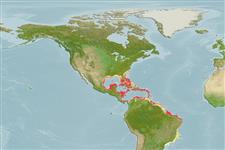Common names from other countries
>
Eupercaria/misc (Various families in series Eupercaria) >
Haemulidae (Grunts) > Haemulinae
Etymology: Haemulon: Greek, haimaleos = bloody (Ref. 45335).
Environment: milieu / climate zone / depth range / distribution range
Ecologia
marinhas associadas(os) a recifes; intervalo de profundidade 0 - 60 m (Ref. 36484). Subtropical; 34°N - 34°S, 98°W - 34°W
Western Atlantic: Bermuda, South Carolina (USA), and northern Gulf of Mexico to Brazil; throughout the West Indies and the coasts of Central America (Ref. 3798).
Comprimento de primeira maturação / Tamanho / Peso / Idade
Maturity: Lm 16.0 range ? - ? cm
Max length : 30.0 cm TL macho/indeterminado; (Ref. 7251); common length : 17.0 cm TL macho/indeterminado; (Ref. 3798)
Espinhos dorsais (total) : 12; Raios dorsais (total) : 14 - 15; Espinhos anais: 3; Raios anais : 8. Mostly yellow, paler below. Scales below lateral line in oblique rows and much larger than those above lateral line. No other grunt has enlarged scales below the lateral line (Ref. 26938).
Occurs in large schools on rocky and coral reefs, often under ledges or close to elkhorn coral (Ref. 9710). Juveniles abundant in near-shore seagrass beds (Ref. 9710). Feeds mainly on small crustaceans (Ref. 3798). Marketed fresh (Ref. 3798).
Ciclo de vida ou comportamento de acasalamento
Maturities | Reprodução | Spawnings | Egg(s) | Fecundities | Larvas
Oviparous, distinct pairing during breeding (Ref. 205).
Robins, C.R. and G.C. Ray, 1986. A field guide to Atlantic coast fishes of North America. Houghton Mifflin Company, Boston, U.S.A. 354 p. (Ref. 7251)
Status na Lista Vermelha da UICN (Ref. 130435)
CITES (Ref. 128078)
Not Evaluated
Ameaça para os humanos
Reports of ciguatera poisoning (Ref. 30303)
Uso pelos humanos
Pescarias: espécies comerciais; Aquário: Aquários públicos; isca: usually
Ferramentas
Relatórios especiais
Baixar XML
Fontes da internet
Estimates based on models
Preferred temperature (Ref.
115969): 25.4 - 28, mean 27.2 (based on 240 cells).
Índice de diversidade filogenética (Ref.
82804): PD
50 = 0.5000 [Uniqueness, from 0.5 = low to 2.0 = high].
Bayesian length-weight: a=0.01380 (0.00879 - 0.02168), b=3.00 (2.87 - 3.13), in cm Total Length, based on LWR estimates for this species & Genus-body shape (Ref.
93245).
Nível Trófico (Ref.
69278): 3.5 ±0.1 se; based on diet studies.
Resiliência (Ref.
120179): médio(a), tempo mínimo de duplicação da população 1,4 - 4,4 anos (K=0.24).
Fishing Vulnerability (Ref.
59153): Low to moderate vulnerability (32 of 100).
